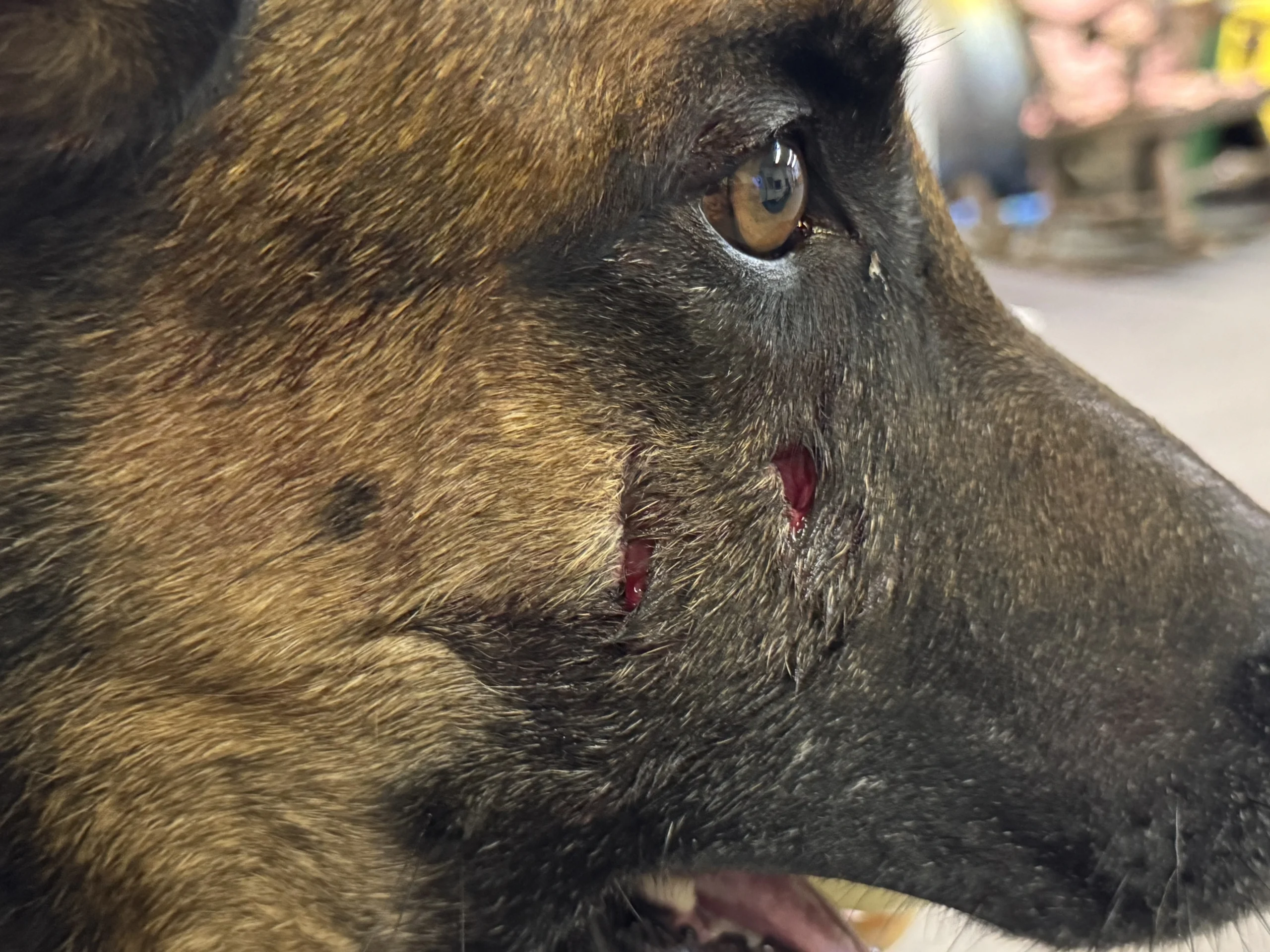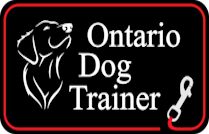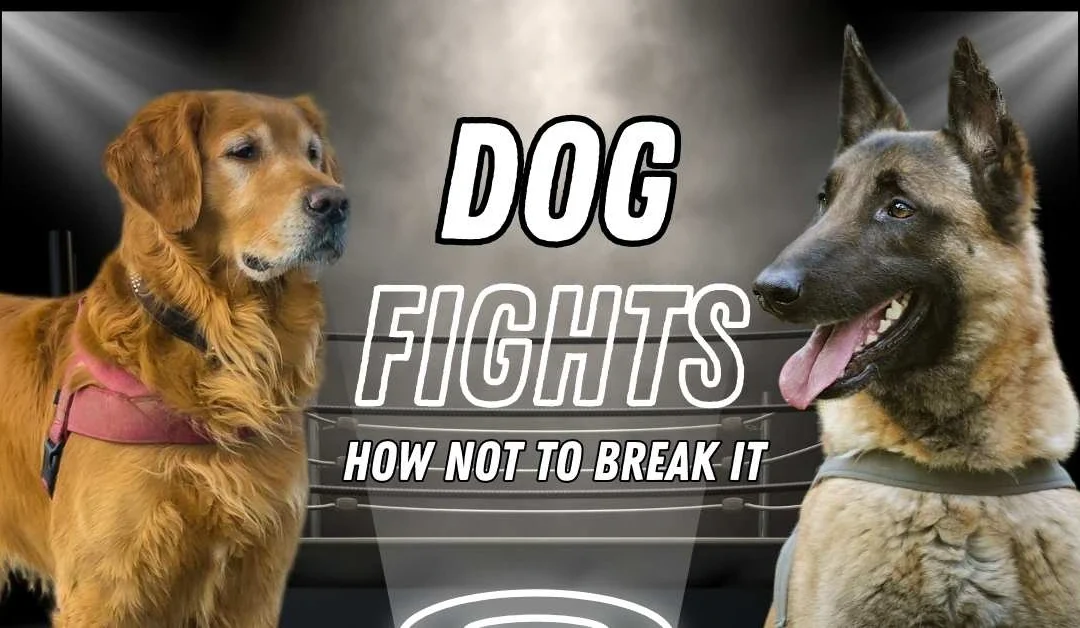Who Do You Think Is Most Likely to Instigate Dog Fights?
A Golden Retriever or a Belgian Malinois?
If you guessed the Belgian Malinois, you’re wrong. This story involves my buddy, Prince, a Belgian Malinois who helps me with everything from training to chasing balls in the yard. He’s not a fighter—he’s my right-hand dog who keeps the peace and prefers to be chased rather than doing the chasing. But what happens when the peacekeeper meets his match? Let me tell you, even dog trainers face situations we’d rather not.
This story involves two well-matched dogs—my Malinois, Prince, and a Golden Retriever named ‘Buddy’ (not his real name), boarding with us for training. What started as playful interaction turned into a full-blown fight, and let me tell you, dog fights escalate faster than you’d believe.
Playtime Gone Wrong
Prince and Buddy have a history of playing well together on our 100-acre property. They’ve shared the yard, hiked together on the trail, played chase, and have always gotten along—until one day, they didn’t. The morning started like usual. The dogs were out in the field, running and playing. I noticed Buddy was acting bolder than usual, getting in Prince’s face more than he (or I) liked.
Now, if you’ve worked with dogs, you know that tension can build subtly. One dog pushes boundaries, the other tolerates it—until they don’t. I thought we could redirect and keep things moving, but things unravelled quickly.
When a Fight Breaks Out
As we headed from the field back to the kennel house for their morning break, Max decided to push Prince’s personal boundaries. Prince had his ball in his mouth —his absolute favourite thing in the world—and Buddy lunged at Prince’s face for it. Before I knew it, they were locked in a fight.
Let me paint the scene for you: two dogs, each over 80 pounds, locked together. The Golden was going for Prince’s face, and Prince was defending himself, though he’s not a fighter by nature. I was yelling for help, a human instinctive behaviour while trying to separate them, but with bulky mitts on and slippery footing, I couldn’t get a grip. I could grab the collar of one dog, but not the other – and this only served to give the advantage to the dog who was ‘free’.
Here’s where things get real—experience has taught me not to put my hands between fighting dogs. It’s a recipe for disaster (and a trip to the hospital emergency room). But in that moment, nothing was working. I couldn’t choke the other dog off, couldn’t twist collars, couldn’t get enough leverage to separate them and didn’t have a break stick available.
The Fight Intensifies
At one point, I ended up flat on my back in the snow, with both dogs on top of me still going at it. I screamed for help, but being in the middle of nowhere, there was no one around to hear me. My husband was home, but inside the house and unaware of the chaos outside.
Buddy wasn’t letting up, and Prince, though not instigating, wasn’t backing down. The fight escalated as Buddy released Prince’s muzzle only to go for the back of his neck. Prince held his own, grabbing Buddy’s ear, and even then, he didn’t puncture it. That’s Prince—firm but fair.

The Desperate Attempt: Walking Away
When all else failed, I made a split-second decision: I walked away. Not because I was giving up, but because I needed another strategy. The water-filled bucket was my next move, but it was 100 yards away in the kennel house. I quasi-ran to fill it, fully expecting to return to a bloodbath or worse.
But here’s the twist—by the time I got to the sink to fill the bucket, the fight was over. Both dogs were standing behind me, big ‘grins’ on their faces as if nothing had happened.
Assessing the Damage

Prince came out of it with a swollen face, a puncture wound and a scrape on his chin—and a cheek bite that didn’t even puncture the skin. The Golden Retriever? Not a scratch. It’s incredible how dogs can move on so quickly after something so intense.
I kenneled them separately for the rest of the day. They didn’t (and won’t) interact again, and every precaution is taken to ensure there will be no more fights. They can hang out in the same room – with one dog in a crate and one dog roaming free – without an issue.
Why Did They Stop?
Here’s where the armchair experts will chime in: “You should’ve done this,” or “Why didn’t you try that?” But here’s the truth— sometimes dog fights resolve themselves when we remove our presence and let the dogs figure it out.
When I walked away, I wasn’t abandoning them. I was running to get water, but in the few seconds of my absence, they realized the fight wasn’t worth it. Maybe it’s leadership, maybe it’s loyalty, or maybe they were just done. Whatever the reason, they stopped.

P.S – This is not ‘Buddy’ in the photo
Lessons Learned from This Dog Fight
1. Know Your Dogs
- Prince is not a fighter, but he won’t tolerate disrespect. Buddy had been pushing boundaries, and tension had been building with each play session. Recognize and interrupt the warning signs before things escalate.
2. Stay Safe
- Never put your hands between fighting dogs. It’s instinct to want to pull them apart, but you’re likely to get bitten. Tools like break sticks or air horns can help, but they aren’t always within reach when fights erupt unexpectedly. Choking off the air supply of the dog with the grip is my go-to action, but this case proved that it doesn’t always work.
3. Remove Yourself if Necessary
- Walking away isn’t an ideal strategy, but sometimes it’s your only option. Removing your presence can defuse the adrenaline, allowing the dogs to cool off.
4. Always Assess the Aftermath
- Check both dogs thoroughly after a fight. Even if they seem fine, injuries can be hidden beneath the fur. Clean any wounds immediately and monitor for swelling or infection.
What Could I Have Done Differently?
Could I have prevented this fight? Maybe. Hindsight is always 20/20.
I could’ve separated them earlier when I noticed Buddy’s behavior changing. But as dog trainers, we know we can’t predict everything.
Could I have used a break stick? Sure, but I didn’t have one on hand—and even if I did, using it effectively in the heat of the moment isn’t easy.
Would water have worked? Possibly, but I didn’t have a source nearby.
The reality is, dog fights happen, even to the most experienced trainers. The best we can do is learn from them and share those lessons with others.
What to Do If Your Dogs Fight
- Stay Calm – Panicking only adds to the chaos.
- Avoid Using Your Hands – Keep your body out of harm’s way.
- Try Noise Distractions – Loud sounds like an air horn can sometimes break up a fight.
- Use Water If Available – A bucket of water or hose can help separate fighting dogs.
- Separate and Evaluate – Once the fight ends, give both dogs safe space (preferably in a crate or kennel) and assess their injuries.
What I Learned from This Dog Fight
Sharing this story wasn’t easy, but it’s important. Dog fights are part of life with dogs, whether you’re a professional trainer or a pet owner. The key is to be prepared, stay calm, and learn from every experience.
If this story helped you, or if you have your own insights, let me know in the comments. And if you’re looking for more dog training tips, subscribe to my YouTube channel. Let’s hit 2,000 subscribers so we can keep bringing you real, practical advice—minus the sugar coating.
Thanks for reading, and remember: even when the unexpected happens, you’ve got what it takes to handle it. Keep training, keep learning, and keep showing up for your dogs.
– Karen Laws
The Ontario Dog Trainer
Join my Email List to get frequent updates, free downloadables, and dog training tips! Click here to subscribe.
Other Blogs to Read:
- Dog Separation Anxiety
- Making Muzzle Training Fun
- Adopting a Shelter Dog? Mistakes to Avoid
Get the latest updates when we publish new freebies and guides by signing up. Your dog will thank you, and you’ll be the first to know when new gifts are available!
Let’s stay connected:

